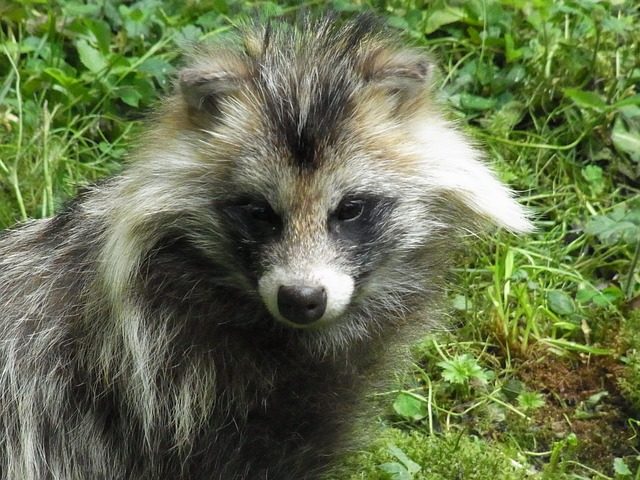Have you ever encountered a curious creature that appears to be a blend of a raccoon and a dog? Meet the raccoon dog, a fascinating and adaptable animal that continues to intrigue and captivate people worldwide. In this blog post, we will journey into the world of the raccoon dog (Nyctereutes procyonoides) and discover its unique origins, physical features, social behavior, habitat preferences, diet, reproduction, and more. Are you ready to unravel the mysteries of this enigmatic animal? Let’s begin!
Table of Contents
Key Takeaways
This essay explores the origins and expansion of raccoon dogs, a captivating species native to eastern Asia.
Raccoon dogs possess physical features and adaptations that enable them to thrive in diverse environments across eastern Asia and Europe.
Raccoon dog populations must be monitored due to their potential negative impact on native species through competition for resources, diseases transmission, hunting or fur farming.
Discovering Raccoon Dogs

Raccoon dogs, also known as Japanese raccoon dogs or tanukis, are captivating animals that have captured hearts and inspired folklore for centuries. These small canids, not to be confused with the common raccoon, are native to eastern Asia and have successfully adapted to various environments across the continent. With their scientific name Nyctereutes procyonoides, which translates to “night wanderer,” raccoon dogs are well-suited to their nocturnal lifestyle, and their unique ability to climb trees sets them apart from other wild dogs.
We will further examine the origins and expansion of these fascinating creatures, including wild animals and other animals, on the animal diversity web.
Asian Raccoon Dog Origins
The raccoon dog’s natural range spans eastern Asia, including:
Siberia
China
Vietnam
Korea
Japan
Known scientifically as Nyctereutes procyonoides, the common raccoon dog is a distinct species with a long history in countries like Japan, where it is often referred to as the tanuki.
The Japanese raccoon dog is unique among canids, with adaptations that allow it to thrive in diverse environments, from cold winters in northern Vietnam to the lush forests and marshes of Asia, similar to its relative, the Chinese raccoon dog.
European Expansion
The raccoon dog’s journey to Europe began with the fur-farming industry. Accidentally released or escaped individuals established wild populations that have since spread throughout various European countries, including:
Finland
Sweden
Norway
Poland
Romania
Czech Republic
Slovakia
Germany
France
Austria
Hungary
Today, raccoon dogs are considered invasive species in some regions of Europe, where they compete with native wildlife for resources and can potentially transmit diseases.
Physical Features and Adaptations

Raccoon dogs possess a unique set of physical features and adaptations that allow them to thrive in diverse habitats. Some of their key characteristics include:
Thick coat of brown, gray, tan, and black hair, which helps them blend in with their surroundings and adapt to various climates
Dexterous front paws, enabling them to climb trees in search of food
Keen sense of smell, helping them locate prey on the ground
These features make raccoon dogs well-equipped to survive and thrive in their environments.
We will further examine some of the raccoon dog’s most notable features.
Fur Coats and Guard Hairs
The raccoon dog’s thick fur serves multiple functions, providing insulation during colder months and camouflage against potential predators. Their fur consists of various hues and guard hairs, which protect the raccoon dog’s skin and add to their distinct appearance.
In the winter, their fur becomes thicker and darker, allowing them to blend in with their environment and survive harsh conditions.
Dexterous Front Paws
One of the raccoon dogs most fascinating adaptations is its dexterous front paws. These nimble appendages allow them to manipulate objects and even climb trees in search of food, setting them apart from other canids like domestic dogs and wild cats.
This tree-climbing ability is a rare trait among members of the canid family, highlighting the raccoon dog’s unique evolutionary path and adaptability.
Social Behavior and Communication

Raccoon dogs are social animals, typically living and hunting in pairs or small family groups. They rely on a combination of communication methods, including:
Scent marking
Latrines
Vocalizations
Body language
These closely related methods allow them to communicate and exchange information with one another.
Understanding the intricacies of raccoon dog social behavior and communication can provide valuable insights into their daily lives and the secrets of their success as a species.
Scent Marking and Latrines
Scent marking and latrines are essential communication tools for raccoon dogs. These methods allow them to share information about their territory, reproductive status, and social hierarchy with other raccoon dogs in the area.
Scent marking involves releasing pheromones to designate their domain, while latrines are designated areas where raccoon dogs collectively urinate and defecate, facilitating data exchange among family members and unfamiliar individuals.
Vocalizations and Body Language
In addition to scent marking and latrines, raccoon dogs use vocalizations and body language to communicate with one another. Their vocal repertoire includes growls, barks, and whines, each conveying specific messages and emotions.
Body language, such as tail wagging, ear position, and facial expressions, also plays a crucial role in raccoon dog communication, helping them navigate complex social interactions and maintain harmony within their groups.
For more info, visit What is the behavior of a raccoon dog?
Habitat Preferences and Adaptability
Raccoon dogs have a remarkable ability to adapt to various habitats, from dense forests and marshes to urban environments. Their preference for habitats with abundant undergrowth and water sources enables them to thrive in a diverse array of ecosystems across their native and introduced ranges, proving that raccoon dogs belong in these diverse environments.
We will further examine the habitat preferences and adaptability of the raccoon dog.
Proximity to Water Sources
Raccoon dogs favor habitats with plentiful undergrowth and water sources, such as forests, marshes, and reedbeds. These environments provide the necessary cover and resources for raccoon dogs to flourish and raise their young.
Their adaptability to various habitats has played a significant role in their success as a species, allowing them to colonize new territories and establish stable populations.
Human Habitats and Scavenging
Raccoon dogs are also known to adapt to human habitats, often scavenging for food in urban areas where raccoon dogs live. Their ability to find sustenance in garbage cans and dumpsters allows them to survive in close proximity to humans, demonstrating their impressive adaptability and resilience.
However, this proximity to human populations can also expose raccoon dogs to threats such as hunting, road accidents, and habitat loss.
Diet and Feeding Habits
As omnivores, raccoon dogs consume a diverse diet, which is why understanding the diet raccoon dogs rely on is crucial. Their diet includes:
Insects
Rodents
Amphibians
Birds
Fish
Reptiles
Mollusks
Carrion
Fruits
Nuts
Berries
Their varied diet and unique feeding habits enable them to thrive in a wide range of environments and adapt to changing food sources.
We will further examine the opportunistic foraging and distinct dietary adaptations of the raccoon dog.
Opportunistic Foraging
Raccoon dogs are opportunistic omnivores, meaning they will consume a variety of animals and plant material depending on availability. Their versatile eating habits enable them to scavenge for sustenance and capitalize on any accessible food sources, making them highly adaptable to diverse environments.
This adaptability is a key factor in their success as a species, allowing them to thrive in both their native and introduced ranges.
Unique Dietary Adaptations
In addition to their opportunistic foraging, raccoon dogs possess unique dietary adaptations, such as fishing and eating sea carrion. They have been observed fishing in shallow waters, using their dexterous front paws to capture small fish.
Raccoon dogs, sometimes compared to raccoon Mario due to their similar appearance, have also been known to submerge themselves in water to catch fish, demonstrating their incredible adaptability and resourcefulness in the face of changing food sources.
Reproduction and Parental Care
Raccoon dog reproduction is a fascinating aspect of their biology, with breeding seasons, litter sizes, and parental care playing significant roles in the success of their offspring. Both parents actively participate in raising their pups, ensuring their survival and development until they reach independence.
We will further examine the complexities of raccoon dog reproduction and parental care.
Breeding Season and Litter Size
Raccoon dogs have a breeding season that typically occurs from February to April, with females entering the Estrus annually following hibernation. The average litter size for raccoon dogs is 5-7 pups, providing a strong foundation for the growth and development of their populations.
This relatively large litter size ensures the continued success and expansion of raccoon dog populations across their native and introduced ranges.
Pup Development and Independence
Both raccoon dog parents play an active role in raising their pups, providing food, protection, and guidance until the pups become independent at around four and a half months of age.
This shared responsibility and investment in their offspring’s well-being is a testament to the raccoon dog’s adaptability and resilience, ensuring the future of their species in the face of various challenges and threats.
Threats and Conservation Status
Despite their adaptability and success as a species, raccoon dogs face various threats, including hunting, fur farming, and invasive species concerns. The conservation status of raccoon dogs is not currently endangered, but their populations are affected by human impact and habitat loss.
We will further examine the various threats faced by raccoon dogs and their current conservation status.
Human Impact and Fur Farming
Human impact, such as hunting and fur farming, poses a significant threat to raccoon dog populations. The demand for raccoon dog fur has led to a decrease in wild populations, as they are targeted for their pelts and meat.
Fur farming has also contributed to the decline of raccoon dog populations in certain regions, as individuals are captured and bred for their fur.
Invasive Species Concerns
As an invasive species in some areas, raccoon dogs can have a negative impact on native wildlife by competing for resources and transmitting diseases such as rabies, echinococcosis, mange, and trichinellosis.
These concerns highlight the importance of monitoring and managing raccoon dog populations to protect native ecosystems and maintain a healthy balance between them and other species.
Raccoon Dogs and Pet Suitability
The suitability of raccoon dogs as pets is a topic of interest for many animal enthusiasts, as their unique appearance and behaviors may seem appealing. However, legal restrictions, regulations, and the challenges raccoon dogs face in captivity make them unsuitable as pets for most individuals.
We will further examine the challenges faced by raccoon dogs in captivity and the reasons for their unsuitability as pets.
Legal Restrictions and Regulations
In some countries, such as the UK, legal restrictions and regulations prevent the sale and ownership of raccoon dogs as pets. Additionally, in certain states of the US, it is mandatory to obtain a permit from the U.S. Fish and Wildlife Service for owning a raccoon dog.
These regulations are in place to protect both raccoon dogs and native wildlife from the potential negative impacts of raccoon dog ownership.
Rescued Raccoon Dogs
Rescued raccoon dogs often require specialized care and rehoming in wildlife parks or zoos, as they are not suitable for life in domestic environments. The unique needs and challenges raccoon dogs face in captivity, combined with the potential legal restrictions and regulations, make them unsuitable as pets for most individuals.
Instead, efforts should be focused on conserving and protecting raccoon dog populations in their natural habitats.
Summary
The raccoon dog is a captivating and adaptable animal that has captured the hearts and imaginations of people worldwide. From their unique origins in eastern Asia to their fascinating physical features and social behaviors, raccoon dogs continue to intrigue and inspire. While their adaptability and resilience have allowed them to thrive in diverse environments, raccoon dogs still face threats from human impact and invasive species concerns. As we continue to learn more about these enigmatic creatures, we can work together to protect and conserve raccoon dog populations, ensuring their survival for future generations to appreciate and admire.
Frequently Asked Questions
Are raccoons canines?
Raccoon dogs are members of the Canidae family, while raccoons belong to the Procyonidae family. They are not related to one another and raccoon dogs are not actually dogs – they are more closely related to foxes than dogs.
Raccoon dogs have a unique appearance, with a long snout and a thick fur coat. They are also known for their intelligence and resourcefulness, which makes them a popular pet in some parts of the world.
Where do raccoon dogs live?
Raccoon dogs, also known as ‘tanuki’, are native to the forests of Europe and Asia. Specifically, they live in China, Japan, Russia, Vietnam, North Korea, South Korea, Austria, France, Hungary, Poland, Romania, Slovakia, Germany, Sweden, and Finland.
They prefer temperate climates and are members of the canine family.
Are raccoon dogs related to raccoons?
Raccoon dogs and raccoons are not related; rather, raccoon dogs are members of the canid family and are more closely related to foxes.
Can raccoon dogs climb trees?
Raccoon dogs can indeed climb trees thanks to their dexterous front paws that give them the ability to ascend and descend with ease.
What is the raccoon dog’s preferred habitat?
Raccoon dogs prefer habitats with abundant undergrowth and water sources, such as forests, marshes, and reedbeds, providing them with the perfect environment to thrive in.









